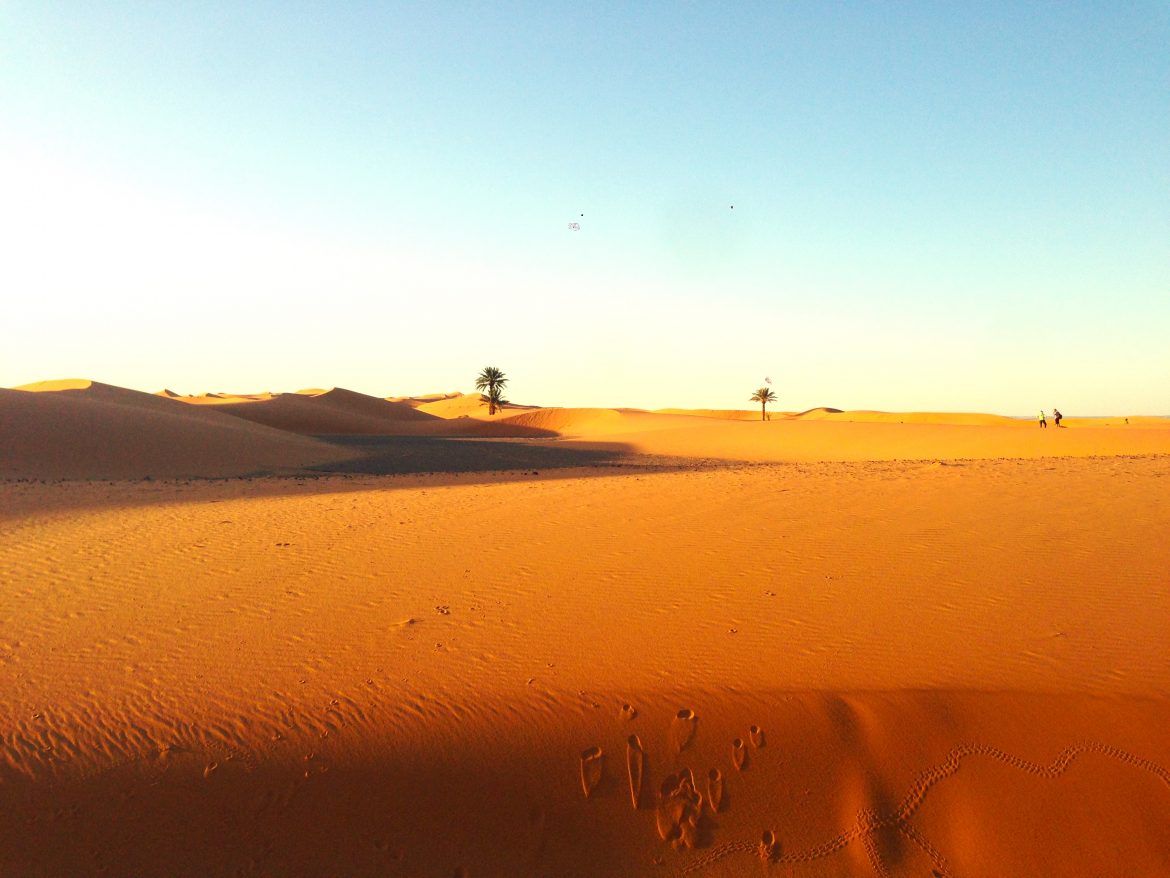Navigate to Section
Morocco is a diverse country with stunning geography, including the Atlas Mountains in the west, the vast Sahara Desert in the east, and many different landscapes in between. Morocco’s diverse terrain and wide range of ecosystems enhance the country’s natural beauty and contribute significantly to its geopolitical and socio-cultural history.
For an enriching experience in Morocco, we highly recommend visiting three distinct destinations: Chefchaouen – the Azure Pearl, the desert of Merzouga, and Morocco’s geological deposits.
Itinerary Tip: Fez to Chefchaouen is a three-and-a-half-hour drive, and Marrakesh to Merzouga is an 8-hour drive, with El Bourouj (known for fossils and geological deposits) just an hour’s drive from Merzouga. It’s a good idea to plan your itinerary so that you visit Chefchaouen when you’re in Fez. When you’re in Marrakech, you visit Merzouga and El Bourouj, which are known for fossils and geological deposits. We will share a complete itinerary of our visit soon.
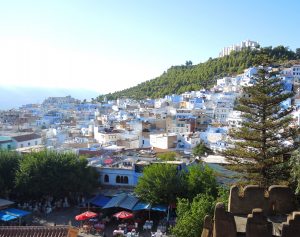
Chefchaouen, Morocco
Chefchaouen- The Azure Pearl
Chefchaouen is known for its picturesque blue-colored buildings and houses in the northwest of Morocco. The town’s buildings are almost entirely adorned with shades of blue, creating a surreal ambiance. While Morocco boasts a range of colorful cities, such as Casablanca in white and others in earthy tones, Chefchaouen stands out with its captivating blue hue.
The decision to paint the entire town blue goes beyond being a tourist attraction; there’s a deeper story behind it. Let’s delve into the city’s history and uncover the origins of this unique color.
Etymology and Historical Roots
‘Chefchaouen’ comes from two Berber words: ‘isakon’ or ‘Chaouen,’ meaning ‘the horns,’ and ‘Chef,’ signifying ‘to look.’ Positioned between the mountains of Tétouan and Ouazzane, Chefchaouen’s panoramic view resembles a valley cradled between two majestic peaks (horns).
Note: The Berbers prefer to be called Amazigh (or Imazighen in the plural), their traditional name. ‘Berber’ has a derogatory history, originating from the Greek term ‘barbarian.’ Hence, the Amazigh people consider it disrespectful to be called by that name. I will use Amazigh/Imazighen instead of Berber/Berbers in the rest of my text.
Blue Wash: Influence of Jewish Refugees or Pest Repellent
Numerous theories exist regarding why the buildings are painted blue. Researchers believe that, although the city was founded in 1471, there was no blue paint until Jews arrived in 1491, escaping the Spanish. The blue color is believed to be a Jewish legacy, symbolizing the sky and heaven. Similar blue houses and architecture can also be found in the holy city of Safed (Tzfat), characterized by winding blue alleyways. If you Google, you will notice similarities between the architecture and the use of blue color in Safed and Chefchuan.
Others believe that the blue color holds practical value. People used limewash with a blue color to protect their buildings from weather damage and repel mosquitoes and other insects, a common practice in regions where bricks are a standard construction material.
Chefchaouen has preserved its distinctive blue hue despite centuries having passed, making it a remarkable destination for visitors seeking a refreshing and unique experience. As a visitor, you feel like you’re in another world, walking through winding streets and cobalt-blue-walled houses with flowering plants hanging from the balconies.
The narrow alleys wind like secret passages, inviting you to explore hidden corners. The ancient stones beneath your feet hold stories of centuries past, where Andalusian exiles and Jewish refugees once sought refuge.
The pale sunlight, shadows, and shades of blue blend like a painter’s stroke, enchanting you. The less crowded labyrinth of streets, the absence of traffic noise, and the warm welcome of residents make you wander and invite introspection. This description is not just a poetic way of narrating my experience; it was my experience when I cast my first sight on the view.
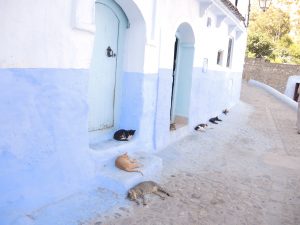
Cats are sitting on one of Chefchuan’s alleys
Geography and Demography of the city
Chefchaouen is situated approximately 600 meters (2,000 ft) above sea level. The city’s foundation is rooted in the architectural style of an old Islamic medina with walled towns, while modern constructions have expanded beyond the city walls. According to the 2014 census, the municipality of Chefchaouen has a population of 42,786. This population is a harmonious blend of Muslim, Arabic, Imazighen, and Jewish communities.
Chefchaouen is located on an active earthquake field line, and several earthquakes have caused significant damage in this region.
History of Chefchaouen
Ali Ibne Rushed Al Almi established Chefchaouen as a small Kasbah to repel invading Portuguese forces in Morocco. After her husband’s demise, Ali Ibne Rushed Al Almi’s daughter, Sayyida al-Hurra, assumed the role of the first Islamic ruler of Chefchaouen from 1515 to 1542. She is widely acknowledged as an influential figure in the Western Islamic Mediterranean.
Before the arrival of the Spanish, the city and its neighboring mountains were home to the Ghomara Imazighen. Today, approximately 10,000 members of this Imazighen tribal community still reside in the region, maintaining their rich cultural heritage and speaking their native language.
Following the fall of Granada, Spanish refugees established residential settlements, and over the centuries, numerous individuals immigrated to Morocco, profoundly shaping the region’s culture, religion, and architecture.
Spanish refugees established residential settlements and fortified structures to resist Portuguese forces. These settlers constructed Andalusi-style residential houses on the hills’ slopes, initially transforming the city into a fortress. Subsequent expansions included the construction of walls, twelve gates, and mosques. The older mosque, dating back to 1471 and built by Ali Ibne Rushed Al Almi, still serves and adds to the city’s rich history.
Morocco experienced periods of French and Spanish colonization, with the city under the control of both colonial forces until 1956, when the country finally gained independence.
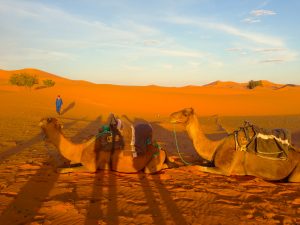
The dunes and Camels
Merzouga Dunes an Overnight Stay Trip
Another popular tourist attraction in the country is the Merzouga Dunes, located near the village of Merzouga in southeastern Morocco. There are two more enormous dunes in the Sahara, Erg Chigaga and Erg Chebbi regions. Erg Chebbi, located near the Merzouga village, offers visitors an awe-inspiring experience and is more accessible than the other one.
To explore the dunes and the surrounding area, many companies provide camel trips that allow visitors to stay overnight at their established campsites for an immersive desert experience. You will embark on a desert trek seated on a camel. The journey commences after sunset, and you will spend the night at one of the encampments set up by tour companies. You will start your return trek early the following day, before sunrise, to avoid the daytime heat typical of deserts. The nights are pleasantly cool, eliminating the need for air conditioning in the tents. Occasionally, the nights may even have a slight chill.
It is widely believed or considered a myth that, during the hottest season, locals in Morocco visit Erg Chebbi and bury themselves neck-deep in the warm sand for short periods as a purported treatment for Rheumatism.
History of the Place Merzouga
Merzouga has a fascinating history. The indigenous population of Western Sahara is the Sahrawi, a blend of Imazighen who have inhabited the region for approximately 2,000 years and Arabs who migrated there in the 1200s. Later, Merzouga became a crucial transit point along the trans-Saharan caravan routes, particularly for merchants traveling to Timbuktu in the 1400s.
Traditionally, the indigenous Sahrawi were engaged in herding and trading. Nevertheless, they established permanent settlements during the colonial era. El Aaiun, a coastal region, was the Spanish colonial capital and remains a significant town. Inland, Smara, located at an oasis, is a historic Muslim monument. The French colonists constructed the recent fortifications in the region between 1916 and 1932.
The enduring fusion of cultures has consistently enriched the region, potentially fostering Morocco’s cultivation of a culturally ingrained sense of contentment and acceptance deeply rooted in its cheerful native Imazighen hospitality. Morocco experienced periods of French and Spanish colonization, with the city under the control of both colonial forces until 1956, when the country finally gained independence.
Some Interesting Facts About Merzouga
- The region has a unique geological landscape, and the vast desert of Merzouga was once part of a shallow ocean, evidenced by the discovery of fossils and mineral deposits scattered throughout the area.
- Merzouga is home to Morocco’s most prominent underground body of freshwater, contributing to the unique geological landscape.
- Due to the absence of humidity and low cloud cover, the desert experiences high fluctuations between daytime and nighttime temperatures. Nighttime temperatures can be 13–20 °C (23–36 °F) cooler on average than daytime temperatures.
- Despite intense daytime heat, nighttime temperatures in the Sahara frequently drop to freezing points, especially in high-elevation areas. However, the belief that nights are freezing after sweltering days in the Sahara is considered a myth.
- Precipitation in the Sahara is scarce, with the annual average ranging from very low to nearly non-existent. The hyper-arid core of the desert receives less than 1 millimeter of rainfall annually.
- The extreme aridity of the Sahara is influenced not only by subtropical high pressure but also by the Atlas Mountains, which act as a barrier, creating a rain shadow effect in the northern part.
- The Sahara is the third-largest hot desert globally, after Antarctica and the northern Arctic, classified as cold deserts. The term “Sahara” is an Arabic word meaning desert.
Fossilized Marble, Erfoud, Morocco
Erfoud, nestled in the Ziz Oasis near the famous Erg Chebbi Desert, is an excellent place for geology and fossil enthusiasts. Morocco features the second-largest phosphate reserves globally, and its amethyst (a well-known gemstone) is naturally purple.
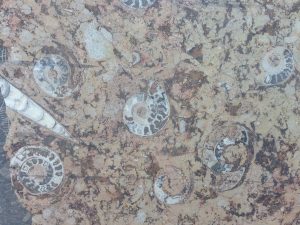
Fossilized Marble Slab After Being Polished
If you’re interested in fossil extraction, you can visit the Museum of Fossils or any local factories in the area to observe firsthand. Imazighen families from Erfoud and Midelt have played a significant role in the mining and restoration of fossils, using hand tools for extraction. The extracted marble rocks undergo hand micro-blasting to reveal fossils, some of which are polished for display. Others are crafted into various decorative household items such as sinks, fountains, soap dishes, countertops, and tabletops.
You can find these unique creations in the souks (bazaars) of Erfoud, Marrakech, and Fes. If you want to purchase more substantial items like fountains, you can order them online and have them shipped worldwide.
Some History About the Geology and Paleontology of Morocco
Morocco has a rich geological history, and fossils dating from the pre-Cambrian (around 541 million years ago) to the most recent geological time (11,700 years ago) can be found in different regions of the country. Morocco’s geological tapestry offers a captivating journey through time for fossil enthusiasts and researchers alike.
Some critical periods and types of fossils found in Morocco include:
- Trilobite fossils from the Devonian period in Erfoud showcase ancient marine life from over 400 million years ago
- Remarkable dinosaur discoveries, including theropods and sauropods, particularly in the Atlas Mountains from the late Jurassic period over 145 million years ago
- The Kem Kem Beds in southeastern Morocco have yielded exceptional finds, notably the iconic Spinosaurus, a giant predator from the Cretaceous period over 66 million years ago and Mammal fossils and fossilized Shark teeth from the Eocene and Miocene epochs 16-11 million years ago
- Significant human artifacts and human footprints of varying sizes on the Northwest coast of Morocco from Pleistocene-era 2.6 million – 11,700 years ago
Morocco’s geological wonders offer a unique mix of nature and history, from the stunning Atlas Mountains to the vast Sahara Desert. Exploring Chefchaouen’s blue streets, embarking on a desert adventure in Merzouga, and discovering the country’s geological deposits are just some of the many fascinating experiences Morocco offers.
